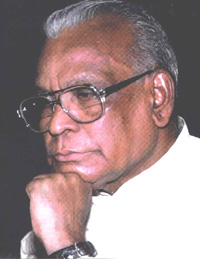|
One Hundred Tamils of
the 20th Century
Ganapati Sthapati
[Nominated by
S.Suriyanarayanan]
Article - Courtesy: Hinduism Today, May-June 2000

 "Following
his profitable conquest of Karnataka, Kerala and northern
Sri Lanka, the Tamil King Rajaraja Chola found himself
with a considerable budget surplus. With vast tracts of
fertile farmland already under year-round irrigation, he
decided to build the largest Siva temple in the world,
Brihadisvara, at Thanjavur (Tanjore in modern Tamil
Nadu state), a stunning masterpiece of stonecraft
engineering. The temple, now on the United Nations
World Heritage List, was crowned in the king's
vision. He capped the 216-foot main sanctum with a single
stone weighing 86 tons and set in place by elephants'
nudging it up a gentle sand ramp starting five miles
away. The great sthapati (architect and sculptor) Kunjara
Mallan Raja Raja Perunthachan was commissioned for the
work. "Following
his profitable conquest of Karnataka, Kerala and northern
Sri Lanka, the Tamil King Rajaraja Chola found himself
with a considerable budget surplus. With vast tracts of
fertile farmland already under year-round irrigation, he
decided to build the largest Siva temple in the world,
Brihadisvara, at Thanjavur (Tanjore in modern Tamil
Nadu state), a stunning masterpiece of stonecraft
engineering. The temple, now on the United Nations
World Heritage List, was crowned in the king's
vision. He capped the 216-foot main sanctum with a single
stone weighing 86 tons and set in place by elephants'
nudging it up a gentle sand ramp starting five miles
away. The great sthapati (architect and sculptor) Kunjara
Mallan Raja Raja Perunthachan was commissioned for the
work.
That's a story that Dr. Vaidyanathan Ganapati
Sthapati, 72, loves to hear, for he is a lineal
descendent of that same Perunthachan of a thousand years
ago. The great man's story reminds Ganapati Sthapati
today of the tradition he is commissioned by birth to
uphold. and of the indomitable spirit of his caste, the
silpis, lords and and masters of South India's hard and
heavy granite.
Though trained in stonecraft as a boy by his father and
uncle, Ganapati Sthapati initially embarked on a career
teaching mathematics. But, as the great poet Valluvar said, "What destiny calls yours
will not depart." In 1957 Ganapati Sthapati joined the
Tamil Nadu government temple board and began overseeing
temple designs and construction.
In 1961 he took over as principal of the government
College of Architecture and Sculpture, Mamallapuram,
which his father and other sthapatis founded just four
years earlier to issue degrees in affiliation with the
University of Madras. For 27 years, until retiring in
1988, Ganapati Sthapati meticulously trained three
generations of temple architects, sculptors and carvers.
He taught them, too, the profound mystical side of the
silpi tradition, how to create not just sculptures, but
the very body of God. During his tenure, he oversaw the
construction of dozens of temples, the carving of
thousands of sculptures and even the construction of a
few secular buildings, such as the library and
administrative offices of the Tamil University in
Tanjore.
Retirement for Sthapati hardly meant extra leisure.
Rather than rest, he launched a private practice and was
commissioned to build temples not oddly in India, but
everywhere Hindus had settled in the past few decades. He
has completed temples in America, England, Singapore,
Malaysia, Fiji, Sri Lanka and Canada. Accomplished
artist, sculptor, designer and project manager that he
is, Ganapati Sthapati also succeeded at a broader and
more meaningful goal: to establish India's ancient
construction arts as an important and useful field of
knowledge in the 21st century. In the process, he has
evaluated each aspect of the ancient art in terms of
modern methods.
The silpis, for example, use simple iron
chisels made and maintained by onsite blacksmiths.
Sthapati experimented with various metals to replace
these iron tools, but ultimately found none an
improvement over the traditional, cheap and easily
created iron ones. As an alternate to breaking out stones
with hand-methods, he tried blasting them lose with
dynamite. But stones so quarried, he discovered, "lost
their tone," and were useless for sculpting.
Noticing the trend toward simpler and simpler sculptures,
Sthapati brought back clever and delicate demonstrations
of the stone carver's art, such as the remarkable stone
bell on a stone chain, with a stone clapper-all carved
from a single rock.
Perhaps closest to Sthapati's heart has been exploring
the philosophical, theoretical and historical traditions
of stone carving. It is a field of knowledge that
encompasses all dimensions of architecture, from
sculpture design to town planning. In the process, he has
generated renewed interest in the Vastu Shastras, the
scriptures of this art, which he is having translated
into English from the their original Sanskrit or ancient
Tamil. Intrigued by the possible relationship between
Maya, the Godly architect in Hindu tradition, and the
Mayan people of South and Central America, he traveled
throughout that region visiting ancient monuments and
meeting with modern Mayan representatives. Repeatedly he
was astounded by similarities between Hindu construction
design and that of the Mayans, right down to the use of
the same measurements and proportions. No explanation has
been offered as to how this occurred, as the two peoples
were never known to have been in Contact.
Throughout his life, Sthapati has worked to revitalise an
ancient art imperiled by technology's usurpation of the
hand-crafted way of life and its deeply spiritual and
aesthetic principles."
V.Ganapati Sthapati, Vastu Vedic Research Foundation,
Plot No.546, First Avenue, Vettuvankeni, Enjambakkam
Village, Chennai 600 048, Tmail Nadu, India email:
[email protected]
|